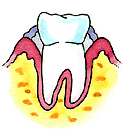
Risk Factors for Periodontal Disease
Several conditions can increase the susceptibility to periodontal disease, by either contributing to the formation of bacterial plaque or/and by reducing the body’s ability to respond to bacterial infections. In presence of any of these risk factors, extra care must be taken including careful oral hygiene and regular dental visits in order to avoid the development of periodontal diseases.
Which conditions increase the risk for Periodontal Diseases?
The most common risk factors for developing gum disease are:
Genetic factors
Several studies indicate that may persons have a predisposal to gum disease. These hereditary causes of gum disease involve several immune system defects that reduce the body’s ability to fight the anaerobic bacteria responsible for causing plaque and periodontal disease. Genetic causes are also linked with some rare early onset types of periodontal diseases in younger age patients with otherwise good oral health. Patients genetically susceptible to gum disease may experience periodontal health problems even if they have good oral hygiene habits. Identification through genetic testing that a patient is in this high risk group should be followed by early interventive treatment to help them keep their teeth.
Female hormones
Any rise in the female hormones level makes women during puberty, menstruation, pregnancy and those using oral contraceptives more susceptible to gum diseases. High levels of progesterone increase the blood flow and fluid retention of the gingival tissues causing swelling, irritation and tenderness of the gums. The inflammation of the gums in combination with poor oral hygiene can cause severe periodontal disease.
Pregnancy
Poor oral hygiene due to morning sickness, and increased vomiting that irritates gums can further worsen the problem. Another common gums problem during pregnancy are the so called ‘pregnancy tumors’, large red lumps formed on inflamed gum tissue near the gum line.
Menopause
Menopause is linked to a painful condition called desquamative gingivitis, where the outer layers of the gums separate from the underlying tissue, exposing nerve endings. The gums become so loose that the outer layers can be easily rubbed away.
Stress
Emotional stress may have negative effects on immune system, increasing the potential of a bacterial infection to develop and cause periodontal disease.
Poor Nutrition habits
A diet low in important nutrients can reduce the ability of the immune system to fight infections, therefore making it easier for dental plaque to cause gum disease. A diet rich in sugars or acids can provide the suitable environment for bacterial overgrowth, promoting gum disease.
Clenching or Grinding Teeth
Clenching or grinding teeth can put the supporting tissues of the teeth under excessive force, damaging the periodontal ligament structures. Combined with an existing gum disease problem, teeth grinding and clenching can cause the faster destruction of periodontal tissues.
Obesity
Obesity could be a potential risk factor for periodontal disease especially among younger individuals.
Socioeconomic Factors
Periodontal disease is considered a disease of the poor. Low income population, ethnic minorities and the elderly show the higher incidence of gum disease, mainly due to lack of access to dental health care and dental insurance.
Other dental problems
Other factors increasing the risk of developing periodontal disease:
- Bridges that no longer fit properly trap food debris and allow dental plaque to accumulate and grow between the crown and gums
- Malocclusion - Crooked teeth make difficult the removal of dental plaque
- Dry mouth helps bacterial growth by increasing the level of mouth’s pH due to reduced flow of saliva that plays a regulatory role.
- Mouth breathing can cause dry mouth increasing the risk of gum disease
Age
Risk factors that may make older people more susceptible include general health status, diminished immune status, medications, depression, worsening memory, decreased salivary flow, functional impairments and change in financial status.
Conclusion
While poor oral hygiene and the overgrowth of certain types of harmful bacteria are the main causes of gum disease, in over 80% of patients with periodontal disease there is also at least one or more of the other predisposing risk factors. Any plan for the prevention or treatment of periodontal diseases should target to eliminate or control as many risk factors and causes of gum disease as possible. Therefore such a plan could involve stopping smoking, changing medications, dietary and oral hygiene habits, correcting faulty restorations or treating malocclusion, in addition to conventional treatments for gum disease such as tooth scaling and root planning or gum surgery treatments.

